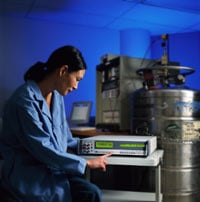- その他のフルークグループ:
- Fluke
- Fluke Biomedical
- Fluke Networks
- Fluke Process Instruments
Ratio calibration—what’s the big deal?
February 2012
 |
Because of my background in precision calibration years ago in the aerospace industry, I still keep tabs on what the Fluke Calibration Group is up to. As a result, I recently received notice that there was a webinar available on the use of the Fluke 8508A Reference Multimeter to perform ratio calibrations. I promptly watched this excellent presentation in its entirety.
In this hour-long presentation, Jack Somppi demonstrates how to perform a precision ratio comparison of two Fluke voltage standards with a near-10:1 ratio of their voltage outputs using only the 8508. He also describes how to perform the same test using the instrumentation I would have used in 1966—the Fluke 720A Kelvin-Varley divider.
The importance of ratio measurements in metrology
Ratios lend themselves to precision applications through the physical nature of many ratio comparison techniques, which have very defined measurement methods with small errors. Historically, ratio measurements have been critical in comparing an unknown to a known similar standard. By measuring ratios, the operator is able to remove other systematic errors from the measurement equation (gain errors, traceability errors, short and long term stability errors, etc.).
Let’s compare the classical tools for measuring ratios to the capabilities of modern digital tools.
More about the 720A
For those of you unfamiliar with the 720A, it is essentially a three-terminal potentiometer with 0.1 ppm (0.00001 %) resolution and linearity. A major feature of this divider is that it offers self-calibration capability through the use of an internal resistance bridge to compare the resistors used in the largest steps. This design allows for user adjustment so that they are matched in ratio.
The 720A can be used with up to 1,100 volts across the input, but the self-calibration process is performed at relatively low voltages. So, you might ask, how did Fluke verify its performance at such high voltages?
Bootstrap calibration
When I first came to Fluke, in 1966, engineers were in the process of testing the 720A prototypes to determine the product specifications that could be published, and they were pondering the same question.
As it happened, Andrew Dunn of the Canadian Research Council had presented an IEEE paper in 1964 entitled “Calibration of a Kelvin Varley Divider” (see sidebar). I had read and applied the bootstrap techniques he outlined during the following year to verify the performance of a unit in the lab where I then worked.
So, shortly after I arrived at Fluke, I found myself spending a few evenings in the engineering lab working with a lab technician to complete the needed tests on the 720A. These were independent tests that didn’t depend on the internal calibration system, and which could be performed at the 1,000-volt level to verify power coefficients.
To perform the procedure we needed very stable dc power supplies (with better than 0.1 mV stability at the 1,000-volt level for the period of a test) along with sensitive null detectors. We also required the quiet of a deserted lab to achieve the thermal stabilities we needed, hence the work at night.
Using Andrew Dunn’s techniques, we were able to verify the power coefficient effects on linearity and publish a specification that ensured a ± 2 ppm of input limit of uncertainty at the 1,000 volt and 1,100 volt input levels.
Other ratio techniques
Determining the ratios of voltages and resistances is at the heart of many precision standard instruments, such as the Fluke 752A Reference Divider. Here, the divider ratios are calibrated using an elegantly simple process described by B. V. Hamon in 1954.
Instructions for the construction of an experimenter’s version of a 10:1 and 100:1 divider using Hamon’s methods may be found here: An Easy to Build 0.1X and 0.01X Resistive Divider
About the 8508 Reference Multimeter
The big deal about the 8508 is that it uses a state-of-the-art, high resolution, analog to digital conversion process based on pulse width modulation techniques to achieve measurement linearities to hundredths of a ppm. Tedious linearity calibration steps such as those used to linearize a Kelvin-Varley divider are no longer required.
Today, the 8508 can be the ultimate reference for calibrating many of your test tools. And, when the Rear Input terminal option is added, ratio techniques can be used to enhance basic accuracy for voltage and resistance measurements, as was pointed out in the webinar mentioned above. (For more information, read “Migrating from dc voltage dividers to modern reference multimeters”)
When a known standard is connected to the rear input terminals of the 8508 as a reference, the very linear a/d converter of the meter can determine the ratio of a measured unknown to that standard in a very straightforward way.
I was pleased to find out that the accuracy of the process using the 8508 very nearly equaled the performance of the much more complicated manual procedure using the 720A, and it took far less time to set up.
It’s clear that Fluke has come a long way in digital multimeters from an excellent start with the model 8300A Digital Multimeter introduced in 1969.
Andrew Dunn paper on bootstrap calibration of a K-V DividerCalibration of a Kelvin-Varley Voltage Divider Abstract: |
- ホーム
- 製品
- ご購入について
- ニュース
- トレーニングとイベント
- カタログ・資料
- サービスとサポート
- フルーク・キャリブレーション

